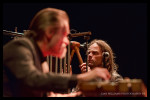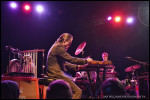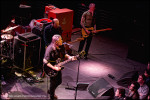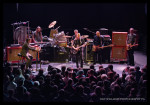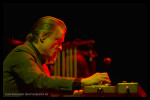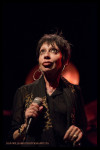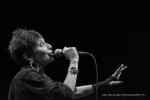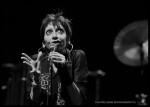by Dan Williams
The line stretched the length of Union Transfer and almost around the block waiting for the doors to open at 8:00. Considering there was an opening act, this was a fairly large crowd anxious for the show to begin. It was not a raucous crowd, but rather a reserved group ready to hear the sonic gymnastics of the loudest performers touring today.
The opening act, Little Annie, aka Annie Anxiety took the stage at exactly 8:30 to no fanfare. Just she and her piano accompanist Paul Walfisch wandered onto the stage to begin the evening. Annie has been touring with the Swans this year and duets on “Some Things We Do” from To Be Kind, their newest album. But that’s where the similarity ends.
I enjoyed her performance very much. She puts the Q in Quirky. Her act is that of a cabaret chanteuse for modern times with two feet still in 1930’s Berlin. She is a flamboyant blend of Edith Piaf and Liza Minnelli … on Xanax. Her songs, with piano accompaniment, are beautifully written, dramatically delivered and a joy to witness. The audience of about 500 was filled primarily with 20-something males. They stood silently transfixed and respectful. I am very happy I was there to experience her … one of the most riveting openers I’ve ever seen.
Between songs, she often stops to speak to the crowd, usually in a self-deprecating fashion. Her story covers all the bases, especially the difficult ones of addiction, a rebellious childhood, communes, musical ups and downs, agony, the difficulties of being a performance artist/actor, ex-patriot and so much more. It appears she has lived on the fringes but is still standing and pushing the rock up the hill every day. Inspiring.
At one point, she stopped a song, looked out at the crowd and marveled to her pianist just how attractive the audience was. She stood there for a minute or so and joked that this was the best looking group of people she had ever seen … “in Philly! Who knew?” and then went on to say “This is the longest relationship I’ve ever had … no, really!” It was right around then that she broke from her originals and sang a vampy version of Tina Turner’s “Private Dancer”. It was both odd and perfect.
During the break between sets, Swans founder Michael Gira strode onto the stage to set up a few things at his post. Back in the day, he had a reputation of being confrontational with audience members. When this audience realized he wasn’t a roadie and began to applaud, he looked out at the crowd with only a glare as acknowledgement, went about his business and departed.
As the lights dimmed, percussionist Thor Harris began a long swirling drone on the gong that lasted nearly five minutes. It felt as if it moved in a circular pattern and flowed in intensity. The audience was already in the zone. Then drummer Phil Puleo wandered onto his riser and seamlessly joined Harris with a gentle roll on cymbals, adding another layer of sound. Decked out in a business suit, Christoph Hahn walked out and assumed his position downstage on pedal steel and began layering in feedback sounds to add to the drone. By this point, we were well into at least ten minutes before the rest of the band, Chris Pravdica (bass / other), Norman Westberg (guitar) and Giro on guitar came onstage, strapped on their guitars and joined in on the wordless drone.
From this point on, it was one of … no, scratch that … it was the loudest musical experience I’ve ever had. Thank God for ear plugs. Swans are a band going back to 1982 that falls under the genres of Experimental Rock, No Wave, Post-Punk, Noise Rock, Industrial, Art Rock, Post-Rock, and Neofolk (don’t ask me about that last one … there was nothing folk-like).
The key sound is mostly instrumental drones played on a huge variety of instruments. Leader Michael Gira adds occasional vocals, but oftentimes, those are wordless drones. Soundscapes of textures and layers laid down very precisely. They have a very dedicated following, all sporting ear plugs!
The second song continued the low droning effect but had a rhythm reminiscent of classic Pink Floyd. There was a strong interplay between Gira and the other players, particularly Hahn to his right and Westberg to his left. It is remarkable to note that this is a band that uses analog instruments to find all of their unique layered sounds. The musicianship is remarkable as they build and build using a wide variety of traditional and non-traditional pieces.
In the audience, I found an occasional person dancing to the swirling sounds, but in most cases, the band had the crowd captivated, still and silent. They seemed to be lost in trances as the layers upon layers of sound would crescendo and then diminish, only to crescendo again. At times they resembled Primus, only heavier. The Industrial feel is constant.
All told, this was a challenging concert not for the casual listener. A fellow concert reviewer/photographer tells me that their recent Antwerp show peaked at 136 dbs. According to a Decibel Comparison Chart, 140 decibels carries this warning: “Even short term exposure can cause permanent damage – Loudest recommended exposure WITH hearing protection.”
And The Who used to boast that THEY were the loudest rock band on earth.


